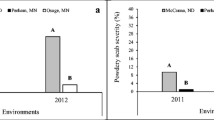Abstract
The level of silver scurf on potato seed tubers on successive generations of potato seed tubers and their progeny tubers was investigated during 3 years in the field. The objective was to determine the importance of seed-borne inoculum on silver scurf development on the subsequent progeny tubers. Silver scurf incidence and severity increased with each generation. Coefficients of determination for disease levels among generations were significant and ranged from 0.89 to 0.97, indicating that seed tuber source accounted for a large proportion of silver scurf on progeny seed tubers. Incidence and severity of silver scurf also increased with decreasing time periods between potato crops in the field. In a field near Paterson, WA, where potatoes had not been previously grown, the severity of silver scurf increased on progeny tubers of cvs Russet Norkotah, Ranger Russet, and Shepody as disease severity increased on seed tubers of successive generations. Disease severity index significantly increased as disease incidence increased. The relationship between the two was best described using a curvilinear regression model.
Resumen
Durante tres años se investigó en el campo el nivel de costra plateada en tubérculos de semilla de papa, en generaciones sucesivas de tubérculos semilla y de su progenie. El objetivo fue determinar la importancia del inóculo trasmitido por la semilla en el desarrollo de costra plateada sobre los siguientes tubérculos progenie. La incidencia y severidad de la enfermedad aumentó en cada generación. Los coeficientes de determinación para los niveles de enfermedad entre generaciones fueron significativos y alcanzaron de 0.89 a 0.97, lo cual indica que la semilla fue la responsable de una gran proporción de costra plateada sobre la progenie de los tubérculos semilla. La incidencia y severidad de costra plateada también se incrementó con menores períodos de tiempo entre cultivos de papa en el campo. En un campo cerca de Paterson, WA, donde no se había sembrado papa anteriormente, la severidad de costra plateada se incrementó en los tubérculos progenie de Russet Norkotah, Ranger Russet y Shepody a medida que la severidad aumentó sobre los tubérculos semilla de generaciones sucesivas. El índice de severidad de la enfermedad se incrementó significativamente a medida que la incidencia aumentó. La relación entre los dos fue mejor descrita utilizando un modelo de regresión curvilínea.
Similar content being viewed by others
Literature cited
Bain PS, VS Bisht and DA Benard. 1996. Soil survival and thiabendazole sensitivity ofHelminthosporium solani isolates from Alberta, Canada. Potato Res 39:23–30.
Cayley GR, GA Hide, PJ Read and Y Dunne. 1983. Treatment of potato seed and ware tubers with imazalil and thiabendazole for control of silver scurf and other storage diseases. Potato Res 26:163–173.
Denner FDN, CP Millard and FC Wehner. 1998. The effect of seed- and soilborne inoculum ofColletotrichum coccodes on the incidence of black dot on potatoes. Potato Res 41:51–56.
Firman DM and EJ Allen. 1993. Effects of windrowing, irrigation and defoliation of potatoes on silver scurf (Helminthosporium solani) disease. J Agric Sci 121:47–53.
Firman DM and EJ Allen. 1995. Transmission ofHelminthosporium solani from potato seed tubers and effects of soil conditions, seed inoculum and seed physiology on silver scurf disease. J Agric Sci 124:219–234.
Frazier MJ, KK Shetty, GE Kleinkopf and P Nolte. 1998. Management of silver scurf (Helminthosporium solani) with fungicide seed treatments and storage practices. Amer J Potato Res 75:129–135.
Goth RW and RE Webb. 1983. Maintenance and growth ofHelminthosporium solani. Am Potato J 60:281–287.
Hide GA and SM Hall. 1993. Development of resistance to thiabendazole inHelminthosporium solani (silver scurf) as a result of potato seed tuber treatment. Plant Path 42:707–714.
Jellis GJ and GS Taylor. 1977. The development of silver scurf (Helminthosporium solani) disease of potato. Ann Appl Biol 86:19–28.
Kamara AM and LE Huguelet. 1972. Host range and overwintering ofHelminthosporium solani. Am Potato J 49:365. (abstr)
Kawchuk LM, JD Holley, DR Lynch and RM Clear. 1994. Resistance to thiabendazole and thiophanate-methyl in Canadian isolates ofFusarium sambucinum andHelminthosporium solani. Am Potato J 71:185–192.
Lennard JH. 1980. Factors affecting the development of silver scurf (Helminthosporium solani) on potato tubers. Plant Path 29:87–92.
Merida CL and R Loria. 1994. Survival ofHelminthosporium solani in soil andin vitro colonization of senescent plant tissue. Am Potato J 71:591–598.
Mooi JC. 1959. A skin necrosis occurring on potato tubers affected by black dot (Colletotrichum atramentarium) after exposure to low temperatures. Eur Potato J 2:58–68.
Read PJ and GA Hide. 1984. Effects of Silver Scurf (Helminthosporium solani) on seed potatoes. Potato Res 27:145–154.
Rodriguez DA, GA Secor, NC Gudmestad and K Grafton. 1995. Screening tuber-bearing solanum species for resistance toHelminthosporium solani. Am Potato J 72:669–679.
Rodriguez DA, GA Secor, NC Gudmestad and LJ Franci. 1996. Sporulation ofHelminthosporium solani and infection of potato tubers in seed and commercial storages. Plant Dis 80:1063–1070.
Sherwood RT and DJ Hagedorn. 1958. Determining common root rot potential of pea fields. Univ of Wisconsin Agric Exp Stn Bull 531.
Zimmerman-Gries S and EC Blodgett. 1974. Incidence and tuber transmission of silver-scurf on potatoes in Israel. Potato Res 17:97–112.
Author information
Authors and Affiliations
Corresponding author
Rights and permissions
About this article
Cite this article
Geary, B., Johnson, D.A. Relationship between silver scurf levels on seed and progeny tubers from successive generations of potato seed. Am. J. Pot Res 83, 447–453 (2006). https://doi.org/10.1007/BF02883505
Accepted:
Issue Date:
DOI: https://doi.org/10.1007/BF02883505




